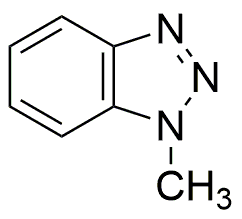1-Methyl-1H-benzotriazole is widely utilized in research focused on:
- Corrosion Inhibition: This compound is effective in preventing corrosion in metals, particularly in the automotive and aerospace industries, enhancing the longevity of components.
- Photostabilizers: It serves as a photostabilizer in plastics, helping to protect materials from UV degradation, which is crucial for outdoor applications.
- Analytical Chemistry: Used as a reagent in various analytical techniques, it aids in the detection and quantification of metals in environmental samples, supporting environmental monitoring efforts.
- Pharmaceuticals: In drug formulation, it can be used to improve the stability of active pharmaceutical ingredients, ensuring efficacy over time.
- Research Applications: It is employed in laboratories for synthesizing other chemical compounds, making it a valuable tool for researchers in organic chemistry.
Informations générales
Propriétés
Sécurité et réglementation
Applications
1-Methyl-1H-benzotriazole is widely utilized in research focused on:
- Corrosion Inhibition: This compound is effective in preventing corrosion in metals, particularly in the automotive and aerospace industries, enhancing the longevity of components.
- Photostabilizers: It serves as a photostabilizer in plastics, helping to protect materials from UV degradation, which is crucial for outdoor applications.
- Analytical Chemistry: Used as a reagent in various analytical techniques, it aids in the detection and quantification of metals in environmental samples, supporting environmental monitoring efforts.
- Pharmaceuticals: In drug formulation, it can be used to improve the stability of active pharmaceutical ingredients, ensuring efficacy over time.
- Research Applications: It is employed in laboratories for synthesizing other chemical compounds, making it a valuable tool for researchers in organic chemistry.
Documents
Fiches de données de sécurité (FDS)
La FDS fournit des informations de sécurité complètes sur la manipulation, le stockage et l’élimination du produit.
Spécifications du produit (PS)
Le PS fournit une description complète des propriétés du produit, notamment sa composition chimique, son état physique, sa pureté et les exigences de stockage. Il détaille également les plages de qualité acceptables et les applications prévues du produit.
Certificats d'analyse (COA)
Recherchez des certificats d'analyse (COA) en saisissant le numéro de lot du produit. Les numéros de lot et de lot se trouvent sur l'étiquette d'un produit, après les mots « Lot » ou « Lot de fabrication ».
Numéro de catalogue
Numéro de lot/série
Certificats d'origine (COO)
Ce certificat d'exploitation confirme le pays dans lequel le produit a été fabriqué, et détaille également les matériaux et composants utilisés et s'il est issu de sources naturelles, synthétiques ou autres sources spécifiques. Ce certificat peut être requis pour les douanes, le commerce et la conformité réglementaire.
Numéro de catalogue
Numéro de lot/série
Fiches de données de sécurité (FDS)
La FDS fournit des informations de sécurité complètes sur la manipulation, le stockage et l’élimination du produit.
DownloadSpécifications du produit (PS)
Le PS fournit une description complète des propriétés du produit, notamment sa composition chimique, son état physique, sa pureté et les exigences de stockage. Il détaille également les plages de qualité acceptables et les applications prévues du produit.
DownloadCertificats d'analyse (COA)
Recherchez des certificats d'analyse (COA) en saisissant le numéro de lot du produit. Les numéros de lot et de lot se trouvent sur l'étiquette d'un produit, après les mots « Lot » ou « Lot de fabrication ».
Numéro de catalogue
Numéro de lot/série
Certificats d'origine (COO)
Ce certificat d'exploitation confirme le pays dans lequel le produit a été fabriqué, et détaille également les matériaux et composants utilisés et s'il est issu de sources naturelles, synthétiques ou autres sources spécifiques. Ce certificat peut être requis pour les douanes, le commerce et la conformité réglementaire.


